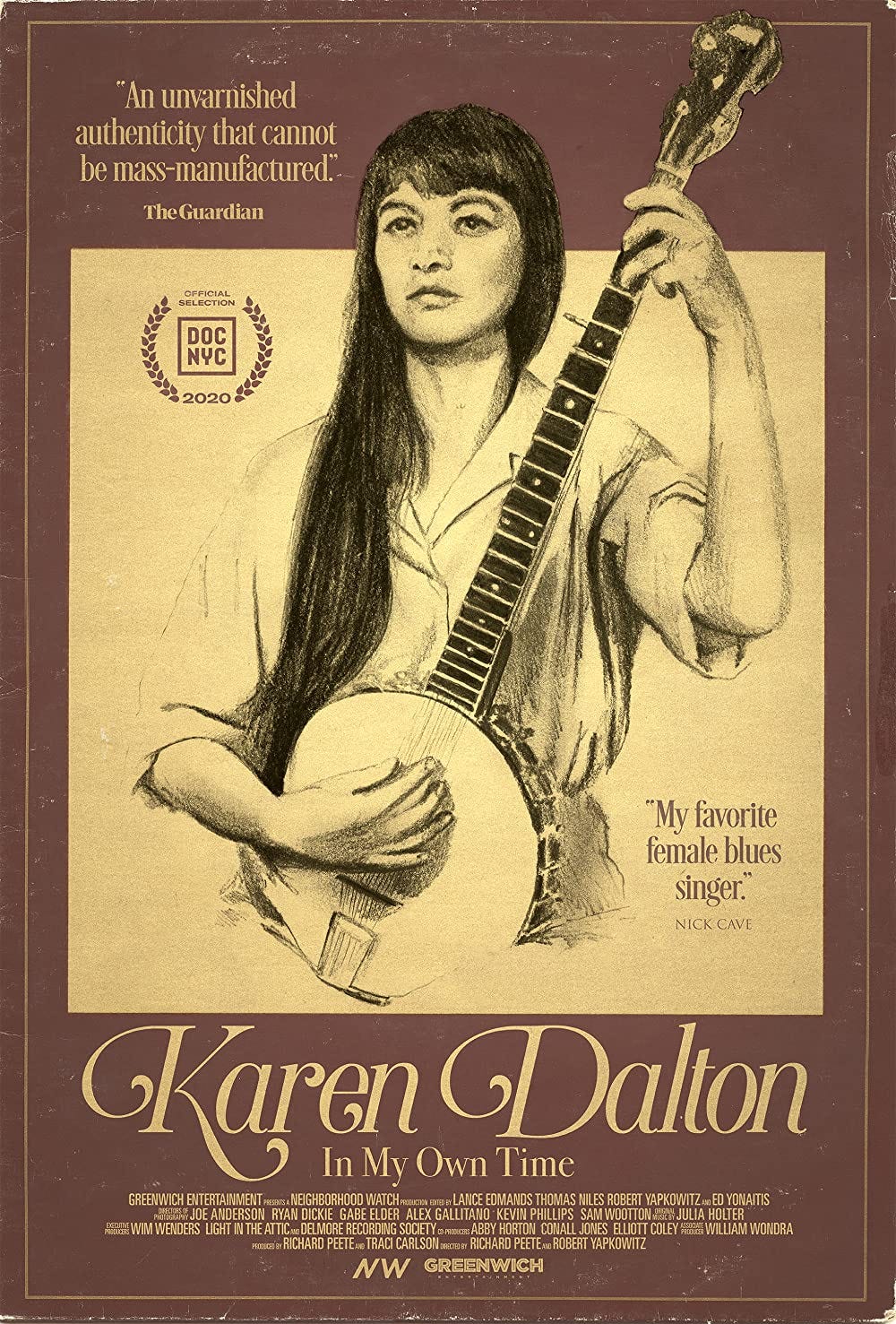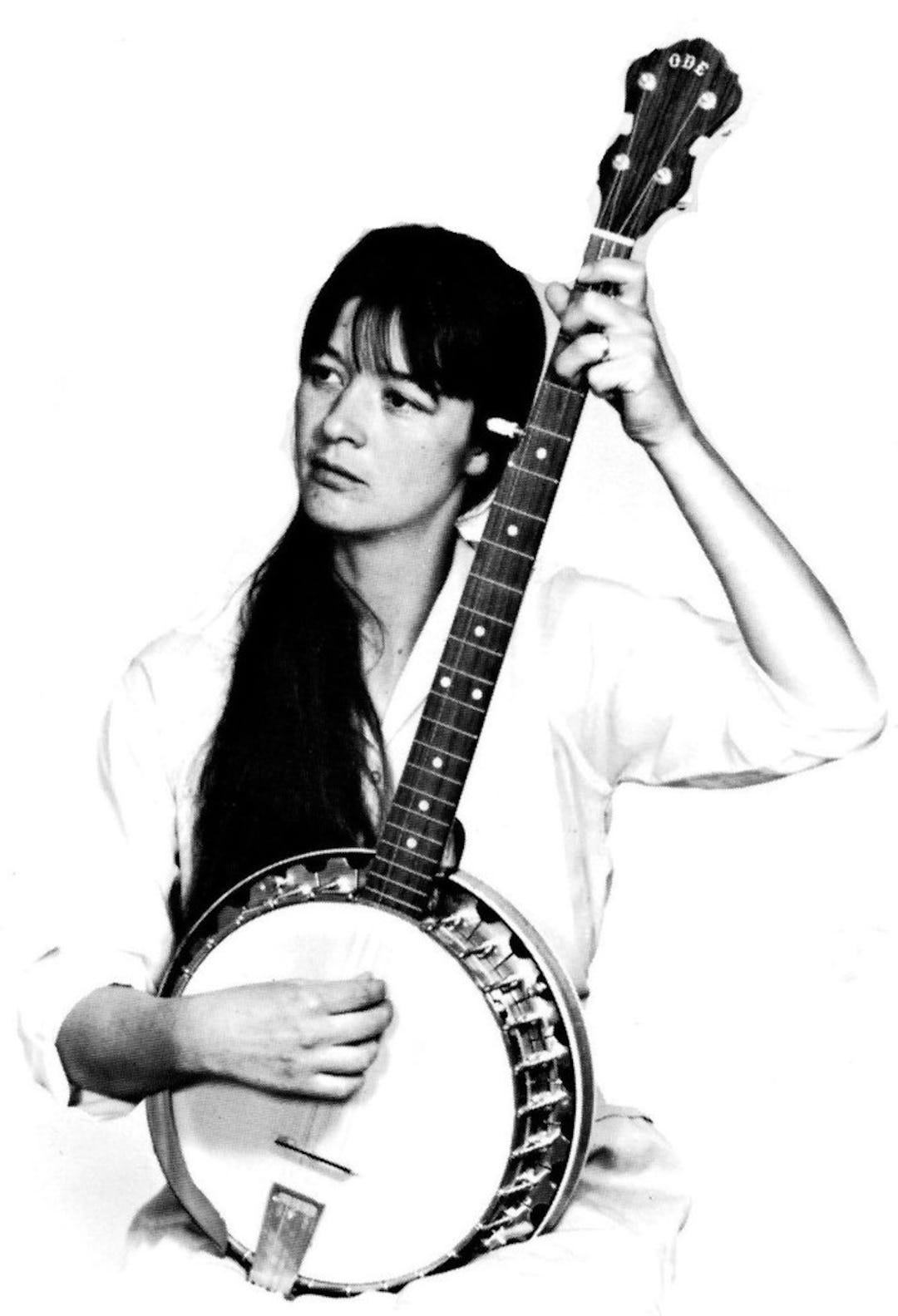The Enduring Enigma of the Late/Great K.T. Kruel (AKA Karen Dalton)
There's a recent film and a lot of talk these days about Karen Dalton. Which I'm glad to hear. Here's my article published in F-Roots UK - 2017.... Enjoy! (with quotes from musician friends Harvey Brooks, Eric Andersen and Peter Stampfel).
The Enduring Enigma of the Late/Great K.T. Kruel
If you happened to have read Bob Dylan’s 2004 memoir Chronicles, you probably caught a reference to a little-known folk singer from his early days in Greenwich Village named Karen Dalton. Bob, who recalled singing “with her a couple of times,” had some heavy praise for Karen Jean Cariker, as she was formerly known in her hometown Enid, Oklahoma, calling her his “favorite singer. Karen [which all agree] had a voice like Billie Holiday and played guitar like Jimmy Reed” [which no one else has ever claimed, although Dalton recorded a sultry version of Reed’s “It Hurts Me Too” on a lightly fingerpicked 12-string in 1969]. Beyond her reputation as the “Hill-Billie Holiday,” Karen was also said to have been the muse for the Band’s yearning Basement Tapes lament “Katie’s Been Gone,” sung by Richard Manuel.
“She can sure sing the shit out of the blues,” crowed Fred Neil, another Greenwich Village legend from back in the day, who not only possessed a deep natural groove to his folk blues but wrote such enduring anthems as “The Dolphins,” and “Everybody’s Talkin’ At Me.” “Her voice,” is so unique that to describe it would take a poet,” Neil claimed. A daunting task indeed. Concoct all the metaphors you can, from purple to fleeting, but Dalton’s weary warble speaks for herself when she sings “I’ll never get out of these blues alive.” There’s no doubting her pain for a minute. As Peter Stampfel of the Holy Modal Rounders once put it, Karen made Janis Joplin sound like Betty Boop.
Dalton’s music is not always easy to listen to. Tragedy clung to her like sinister perfume. Her quavering delivery and the way her songs wobble and stagger before coming to a sudden end, show little to none of the professional production values found on Judy Collins, Joni Mitchell and Joan Baez records of the day. Arrangements be damned. Overdubs on Karen’s albums often seem like an afterthought, an attempt to sweeten the tracks. Although surrounded by excellent studio musicians, she usually sounded best solo. Be sure to hunt down the priceless black and white footage of her on Youtube performing the lilting, lazy “Blues Jumped the Rabbit,” recorded in Summerville, Colorado in 1970. Also strongly recommended is a video of Ms. Dalton fingerpicking her Gibson B-45 twelve-string guitar (complete with a D’Armond pick-up) in some funky folk grotto, which helps bring the long-haired earth-mother troubadour with the turned-down eyes to life.
Having a strong aversion to the studio, Dalton recorded sporadically over her short, tumultuous career beginning with It’s So Hard to Tell Who’s going to Love You the Best (for Capitol Records in 1969) and two years later In My Own Time (1971). Various rarities, including a live album called Cotton Eyed Joe recorded in 1962, was later released in 2007, followed by 2008’s stripped-down Green Rocky Road, a portfolio of home recordings cut in Colorado between 1962 and 1963. More unreleased tracks entitled 1966 came bobbing to the surface in 2012 and three years later, Remembering Mountains: Unheard Songs by Karen Dalton appeared in 2015.
Hoping to fill in a couple of cracks in Karen’s mysterious history, I recently interviewed a few of her old friends and collaborators, including her one-time producer, ex-pat Harvey Brooks, (bassist with Bob Dylan, the Electric Flag and Miles Davis) currently living in Israel.
“I first met Karen in Woodstock through Michael Lang and Fred Neil in 1970 when Lang asked me to produce her new album In My Own Dream,” Brooks recalled. “She loved and respected Billie Holiday and was honored by the comparison but Karen sang Karen. That was all she knew about singing. Most of her influences [on the guitar and banjo] came from rural mountain music and later people like Fred Neil. She played the mood and feel of the song that she was interpreting. I was able to arrange a large part of the rhythm tracks to her taste because of this quality.”
“I didn’t know Karen well,” veteran Greenwich Village singer/songwriter Eric Andersen confessed. “Mostly by reputation and myth. But she sang beautifully on the afternoon I met her in her Woodstock rental house. Fred [Neil] played guitar and I hummed along. She closed her eyes dreamily on a blues. I loved her attitude, loved her singing, loved her soul. She and Billie Holiday were truly sisters in more ways than one.”
Perhaps it should be pointed out that Dalton herself, claimed her brassy, laid-back, behind-the-beat phrasing was more inspired by Bessie Smith than Ms. Holiday, although she recorded and often performed “God Bless the Child.”
“Karen was an interpreter of song. She enjoyed finding good songs and making them her own,” Harvey continued. “Writing songs was not something she did. She felt that her time was better spent finding that special song. Before we started recording Karen, Mike Lang and I spent many hours listening to demos, albums and calling our friends to find songs that would be fun, that would say something, feel good and be challenging to record. After I worked out the song forms with Karen we went to Bearsville Studios to record the rhythm tracks. Karen was comfortable because she sang live with band and we had the option to use the vocal or not which we could determine at a later time. On the tunes like ‘Katie Cruel,’ we did them live with Karen playing and singing. She had consistent time in her playing. At this point in her career, I believe she wanted to make a real attempt to break through her obscurity and was open to my suggestions. We had mutual respect for each other.”
Dalton’s personal life was quite tumultuous. Everyone who knew her would eventually witness the impact drugs had on her life.
“Karen had serious problems with drugs and alcohol,” Brooks concurred. “Her addictions led to ill health and eventually the premature death of another great vocal innovator.
“I hung with Karen and her husband, but she was stoned most of the time,” Mark Ross recalled. “America’s Most Famous Unknown Folksinger,” multi-instrumentalist Mark Ross first came to Greenwich Village in 1967, after the folk scene had already peaked. A new pack of self-styled singer-songwriters and aspiring rock bands now dominated Bleecker and MacDougal Street’s legendary folk clubs like the Kettle of Fish, the Gaslight, and Café Wha?, which had featured nightly sets by Fred Neil, Odetta and Ian and Sylvia.
“By 1968 I was kitchen boy, lighting and sound man, and permanent third act at the Gaslight on MacDougal Street. All for five bucks a night, and a lot of nights I slept on the lobby carpet of the club,” Ross laughed. “Karen was wonderful on stage. She was a riveting singer who phrased behind the beat. She played mostly traditional songs on a long-necked five-string banjo, which was two frets longer than usual. She tuned it down to D instead of E. It was so dire in the Village at the time. During the day, we’d go busking up at the bandstand in Central Park, playing songs like Woody Guthrie’s “The Old Cracked Looking Glass” and “Katie Cruel,” [a song she so strongly identified with that the name above her doorbell to her Sullivan Street apartment read “K.T. Kruel”].
However you choose to spell it, “Katy Cruel” originated as an old Scottish folk tune, which Karen picked on her banjo in a sprightly claw-hammer style. Today the lyric continues to stand as a haunting metaphor for her dark odyssey from Oklahoma, to New York City to Woodstock.
“When I first came to town, they called me the roving jewel.
Now they’ve changed their tune, they call me Katy Cruel.”
Between poverty, addiction, and tumultuous personal life - she allegedly lost a pair of bottom front teeth that were punched out after getting in between two lovers who furiously duked it out over her affections. Not a great look for publicity pics. But Dalton never seemed particularly interested in publicity. Karen was something of a phantom when it came to the music business. There is still no known recorded interview with her, and only a few photos remain, although a few rare clips can be found on Youtube of her picking guitar outside of a cabin and doing chores around the kitchen, living the rustic back to the country dream that rock stars like Bob Dylan, the Band, and Neil Young exemplified in the bucolic backwoods of Woodstock and Topanga Canyon.
While most folksingers who came through the ranks of the Greenwich Village clubs like Folk City and the Bitter End were raised as college-educated/middle-class kids, Dalton’s kin were closer to the source. They sang in church and presented Karen with a fiddle when she was just a child.
Peter Stampfel described Dalton as “a nineteenth-century cowgirl/pioneer woman,” yet simultaneously described her as “queenly” and “brutally honest,” to the point where “she could intimidate anyone.” Part Irish, part Cherokee, Karen appeared quite strong-willed but Stampfel revealed a more vulnerable side of her personality when he recalled rehearsing with Dalton for gigs that never happened. She would often wind up finding some last-minute excuse like “feeling under the weather” and inevitably canceling the performance. “She disliked performing almost as much as she loved music,” Peter explained. Karen preferred to “just play music with friends in her living room,” which perfectly explains the “porchy” sound and feel of most of her recordings, except for In My Own Time, a mixed bag that leapt from the soulful sway of Percy Mayfield’s “When a Man Loves a Woman,” to a punchy take of the Band’s “In a Station.” While Dalton’s live set was comprised of traditional folk songs, her records featured recent compositions written by her peers, Fred Neil and Tim Hardin.
“No one was interested in the old songs anymore,” Mark Ross said. “By the late sixties, you had to be a singer-songwriter to get a record contract. Karen got by because she had such a powerful voice."
Since her tragic passing from “an AIDS-related disease” in 1993, Ms. Dalton, like Nick Drake, has had a more successful posthumous career. The obsession of a small but fervent cult continues to this day. Beyond the sporadic rare release of some newly discovered home-made tape, is the recent publication of a 160-page bio/comic book, published in September 2017, entitled Karen Dalton – Jeunesse d’une Femme Libre, de Greenwich Village à Woodstock, written in French and illustrated by Cedric Rassat and Ana Rousse.
Everything about Karen Dalton leaves us wondering, wanting more, to find some sense of closure to the enduring saga of her sad, short life. Years later, as various pieces of the puzzle continue to appear, we are still attempting to see the whole picture of her understated brilliance.



